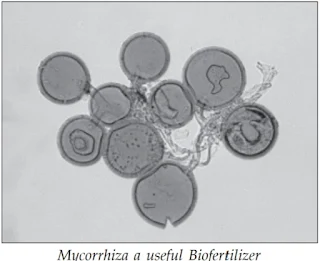Role of biofertlizers in enhancing soil fertility
Role of biofertlizers in enhancing soil fertility.
One of the major concerns in today’s world is the pollution and contamination of soil by the excessive use of chemical fertilisers. The use of chemical fertilizers and pesticides has caused irreparable damage to the environment. The only solution for the recuperation of the damaged soil system is the application of biofertilizers, an environmentally friendly fertilizer now used in most countries. Biofertilizers are organisms that enrich the nutrient quality of soil. The biofertilizers are beneficial organisms that when applied to soil and left with minimal tillage practices help in the building up the population in the farm field. To name some of the biofertilisers are bacteria, fungi, and cyno-bacteria (blue-green algae), mycorrhizae, azospirillium, rhizobium and azotobacter etc. The most striking relationship these have with plant is symbiosis, in which the both the partners derive benefits from each other and in turn help the soil to built and heal the damage done by excess use of chemicals.
Plants have a number of relationships with fungi, bacteria, and algae, the most common of which are with mycorrhizae, rhizobium, and cyanophyceae etc. These are known to deliver a number of benefits including plant nutrition, disease resistance, and tolerance to adverse soil and climatic conditions. These techniques have proved to be successful biofertilizers that form a health relationship with the roots.The following are different kinds of biofertilizers:
Rhizobium
Bacteria of the genus Rhizobium play a very important role in agriculture by inducing nitrogen-fixing nodules on the roots of legumes such as peas, beans, clover and alfalfa.
This symbiosis can relieve the requirements for added nitrogenous fertilizer during the growth of leguminous crops. Various institutes are studying the bacterial and legume genes involved in establishing and maintaining the symbiosis.
Mycorrhizae
Mycorrhizae are a group of fungi that include a number of species based on the different structures formed inside or outside the root.
These are specific fungi that match with a number of host plants on which it grows. These fungi grow on the roots of the agricultural crops. In fact, seedlings that have mycorrhizal fungi growing on their roots survive better after transplantation and grow faster. The fungal symbionts gets shelter and food from the plant, which, in turn, acquires an array of benefits such as higher uptake of phosphorus, salinity and drought tolerance, maintenance of water balance, and overall increase in plant growth and development.
Blue-green algae:
Blue-green algae are considered the simplest, living autotrophic plants, i.e. organisms ca-pable of building up food materials from inorganic matter. They are microscopic. Blue-green algae are widely distributed in the aquatic environment. Certain blue-green algae live intimately with other organisms in a symbiotic relationship. Some are associated with the fungi in form of lichens.
The ability of blue-green algae to photosynthesize food and fix atmospheric nitrogen accounts for their symbiotic associations and also for their presence in paddy fields. Blue-green algae are of immense economic value as they add organic matter to the soil and increase soil fertility.
Azolla:
Azolla is an aquatic fern (pteridophyte), floating on water surface of flooded rice fields,small ponds, and canals. Azolla is useful as a “soybean plant in rice field”, because it can assimilate atmospheric nitrogen owing to the nitrogen fixation by blue green algae living in the cavities located at the lower side of upper (dorsal) lobes of leaf.
Azotobacter
Azotobacter is an aerobic soil-dwelling organism with a wide variety of metabolic capabilities, which include the ability to fix atmospheric nitrogen by converting it to ammonia. It fixes nitrogen in the free-living state and does not enter into symbioses with plants.
Major biofertilisers and target crops
Rhizobium - Leguminous crops (Pulses, oilseeds, fodder)
Azatobacter - Wheat, rice, vegetables
Azospirillum - Rice, sugarcane
Blue green algae (BGA) - Rice
Azolla - Rice
(Source: A study of biopesticides and biofertilisers in Haryana, India Ghayur Alam, 2000)
Friends, how did you like this article, you will definitely tell in the comment section and thank you for visiting our website continuously to get such articles.












Post a Comment